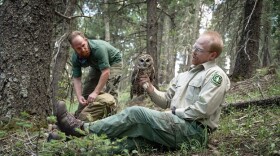-
As winter sets in, rodents seek warmth and food — often in our homes. There are non-toxic ways to control them, from rodent birth control to attracting natural predators.
-
A historic Chino Valley farm that supported Fred Harvey’s railroad dining empire over a century ago is on track to become part of a new state park.
-
Some spiders don’t just spin webs — they listen through them. Researchers found that orb-weavers can sense vibrations on their silk to detect prey and danger.
-
On a walk through the woods, you might see a strange-looking growth up in the branches of a tree. It’s called a witches’ broom.
-
Fire and drought are transforming western forests — and the Mexican Spotted Owl is adapting to survive.
-
Biochar, made from burned plant material, is giving new life to waste — and helping fight climate change in the process.
-
The 64-mile steam train service from Williams to the South Rim of the Grand Canyon began in 1901, when a ticket cost $3.95. An updated, eco-friendly version is still in use today.
-
New research in New Mexico shows that black bears thrive in forests renewed by fire — especially when it means more berries, acorns and cover.
-
A creature inhabits northern Arizona that has every appearance of a diminutive rhinoceros.
-
After sunset, the eerie choruses of coyotes are among the most iconic sounds of the American West.
-
Archaeologists are using advances in technology to analyze fragments of turquoise found at the ancestral Hopi villages of Homol’ovi. They're working with the Hopi Cultural Preservation Office to reveal the story of the origins of these iconic blue-green stones.
-
Fire lookout towers didn't exist in Arizona in the early 1900s. Instead, firefighters use tall ponderosa pines near mountain tops or other strategic viewpoints.
















